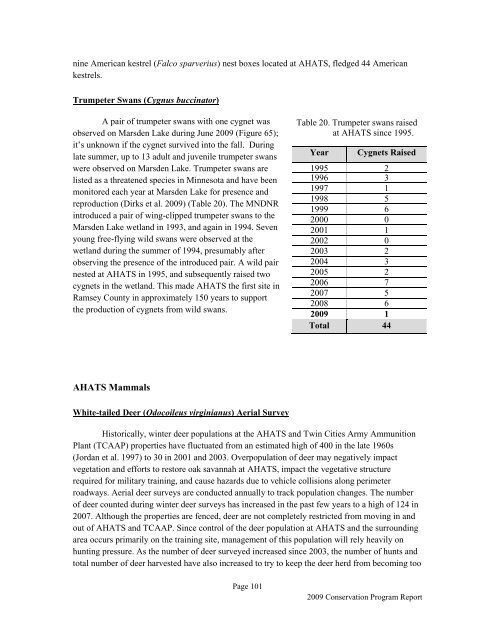camp ripley and arden hills minnesota army national guard training ...
camp ripley and arden hills minnesota army national guard training ...
camp ripley and arden hills minnesota army national guard training ...
You also want an ePaper? Increase the reach of your titles
YUMPU automatically turns print PDFs into web optimized ePapers that Google loves.
nine American kestrel (Falco sparverius) nest boxes located at AHATS, fledged 44 American<br />
kestrels.<br />
Trumpeter Swans (Cygnus buccinator)<br />
A pair of trumpeter swans with one cygnet was<br />
observed on Marsden Lake during June 2009 (Figure 65);<br />
it‟s unknown if the cygnet survived into the fall. During<br />
late summer, up to 13 adult <strong>and</strong> juvenile trumpeter swans<br />
were observed on Marsden Lake. Trumpeter swans are<br />
listed as a threatened species in Minnesota <strong>and</strong> have been<br />
monitored each year at Marsden Lake for presence <strong>and</strong><br />
reproduction (Dirks et al. 2009) (Table 20). The MNDNR<br />
introduced a pair of wing-clipped trumpeter swans to the<br />
Marsden Lake wetl<strong>and</strong> in 1993, <strong>and</strong> again in 1994. Seven<br />
young free-flying wild swans were observed at the<br />
wetl<strong>and</strong> during the summer of 1994, presumably after<br />
observing the presence of the introduced pair. A wild pair<br />
nested at AHATS in 1995, <strong>and</strong> subsequently raised two<br />
cygnets in the wetl<strong>and</strong>. This made AHATS the first site in<br />
Ramsey County in approximately 150 years to support<br />
the production of cygnets from wild swans.<br />
AHATS Mammals<br />
White-tailed Deer (Odocoileus virginianus) Aerial Survey<br />
Page 101<br />
Table 20. Trumpeter swans raised<br />
at AHATS since 1995.<br />
Year Cygnets Raised<br />
1995 2<br />
1996 3<br />
1997 1<br />
1998 5<br />
1999 6<br />
2000 0<br />
2001 1<br />
2002 0<br />
2003 2<br />
2004 3<br />
2005 2<br />
2006 7<br />
2007 5<br />
2008 6<br />
2009 1<br />
Total 44<br />
Historically, winter deer populations at the AHATS <strong>and</strong> Twin Cities Army Ammunition<br />
Plant (TCAAP) properties have fluctuated from an estimated high of 400 in the late 1960s<br />
(Jordan et al. 1997) to 30 in 2001 <strong>and</strong> 2003. Overpopulation of deer may negatively impact<br />
vegetation <strong>and</strong> efforts to restore oak savannah at AHATS, impact the vegetative structure<br />
required for military <strong>training</strong>, <strong>and</strong> cause hazards due to vehicle collisions along perimeter<br />
roadways. Aerial deer surveys are conducted annually to track population changes. The number<br />
of deer counted during winter deer surveys has increased in the past few years to a high of 124 in<br />
2007. Although the properties are fenced, deer are not completely restricted from moving in <strong>and</strong><br />
out of AHATS <strong>and</strong> TCAAP. Since control of the deer population at AHATS <strong>and</strong> the surrounding<br />
area occurs primarily on the <strong>training</strong> site, management of this population will rely heavily on<br />
hunting pressure. As the number of deer surveyed increased since 2003, the number of hunts <strong>and</strong><br />
total number of deer harvested have also increased to try to keep the deer herd from becoming too<br />
2009 Conservation Program Report
















